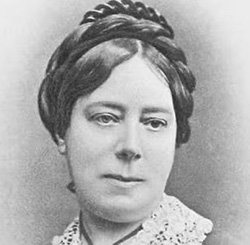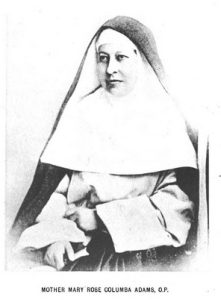New developments in recreation, commercialisation, and industrialisation led to a transformation in occupations available and life during these centuries. In England, although women could work, they could not vote, own land while married, go to a university, earn equal wages, enter many professions, and even report serious cases of domestic abuse. There were no anaesthetics and women sometimes died in childbirth. Infant mortality was high. About one child in four died before their fifth birthday. Most married women had several children but not all would survive.
Some women still played a prominent role in society and church during this time, particularly in social work and hymnody.
Jane Austen, Anne, Emily, and Charlotte Bronte (circa 1775–1855)
Although not known for their Christian influence on society, it is interesting to note that authors Jane Austen and the Bronte sisters, Anne, Emily, and Charlotte were members of English parsonage families, their strict fathers being ministers of the Church of England. All women were well educated and spent most of their lives in cloistered vicarages in the unhealthy grounds of a church with burial vaults below, surrounded by vast cemeteries filled with graves of deceased parishioners. Their collective novels are classics of the literary world and a shrewd, if not romantic, observation of life in the early part of the 19th century.

Amalie Sieveking
Amalie Wilhelmine Sieveking (1794–1859)
Amalie was a German philanthropist and social activist who founded the Weiblicher Verein für Armen- und Krankenpflege (women’s association for the care of the poor and invalids). She initiated employment and practical training for the poor and promoted the building of affordable housing and hospitals. She is regarded as a forerunner of modern German social work and leader of the first involvement of German Protestant women in charitable work.
Amalie became a deaconess, deciding early in life to remain single, and vowed to create a religious order of charitable sisters. When cholera broke out in Hamburg in 1831, she volunteered to work as a nurse in the poorhouses. She advertised for other high-ranking women to join her, but none did, so she went alone. Soon she found herself in charge of the nursing staff. She founded her compassionate society that aimed to help people help themselves by providing “material and spiritual assistance” to impoverished sick people and their families. In 1840 she founded the Amalienstift, which had a children’s hospital and a poorhouse. Her organisation inspired others of a similar nature in Germany and, over the next sixteen years, 45 societies affiliated with Amalie’s were established. In 1836, Lutheran pastor Theodor Fliedner was influenced by Amalie when he established the first Protestant hospital in Kaiserswerth, which evolved into a leading modern nursing school. He was also responsible for establishing the deaconess movement in Germany, an order of nurses which attracted widespread enrolment and recognition. Florence Nightingale, the British nurse of Crimean War fame, was trained at Kaiserswerth and was influenced by the work of Sieveking.
Catherine Winkworth (1827–1878)

Catherine Winkworth
Catherine was an English hymnwriter and educator, who translated the German chorale tradition of church hymns for English speakers, for which she is recognised in the calendar of the Evangelical Lutheran Church in America. She also worked for wider educational opportunities for girls.
Catherine spent a year in Dresden, Germany, during which she became interested in German hymnody. Around 1854, she published her book Lyra Germanica, a collection of German hymns which she had chosen and translated into English. A further collection followed in 1858. During 1863, she published The Chorale Book for England, which was coedited by the composers William Sterndale Bennett and Otto Goldschmidt. In 1869 she followed this with Christian Singers of Germany.
The Harvard University Hymn Book, records Catherine “did more than any other single individual to make the rich heritage of German hymnody available to the English-speaking world”. Among the best-known chorales translated by Winkworth are From Heaven Above to Earth I Come (Martin Luther, 1534); Wake, Awake, for Night Is Flying (Philipp Nicolai, 1599); How Brightly Beams the Morning Star! (Nicolai, 1597); and the Christmas hymn A Spotless Rose (Es ist ein Ros entsprungen, anon, 1599).
Catherine translated biographies of two founders of sisterhoods for the poor and the sick: Life of Pastor Fliedner, 1861, and Life of Amelia Sieveking, 1863 (see above).
Australian women of influence
With the more Europeans coming to Australia from the early 1800s, several Christian women are worth noting in the early years of colonisation. Here are two.
Hannchen Nehrlich

The Parsonage at Lobethal, Hannchen Nehrlich’s first home in Australia
(Born about 1780 in Hamburg, Germany)
When the first groups of Lutherans began arriving in South Australia in the late 1830s and early 1840s naturally many of them were women. Very little is known of these brave German immigrants. History shows that the early leaders, Pastors Kavel and Fritzsche, married fellow immigrants after arrival in Australia, both suffering the loss of first stillborn children and wives soon after.
Some interesting anecdotes have been discovered about Pastor Fritzsche’s mother-in-law Mrs Nehrlich. Her Christian name was given as Hannchen on the (Skjold) ship’s list, but everywhere else she was simply referred to as Mrs Nehrlich, the well-to-do widow of a director of music at the Conservatorium in Hamburg and the mother of Dorothea (or Dorette or Dorchen). Mrs Nehrlich accompanied Dorothea who was engaged to be married to Pastor Fritzsche.
Mrs Nehrlich helped to finance the trip to Australia, and later helped pay for the land the party took up in Lobethal. She stayed on in the home of her daughter and son-in-law after their marriage and raised a prolific garden, supplying food for Pastor Fritzsche and the students at the Lobethal college. She also had two cows, supplying butter to the community, and raised pigs. Mrs Nehrlich later moved into her own substantial home around 1844. After Dorothea’s death in 1845, her son-in-law lived with her until his death in 1863.
Another daughter of Mrs Nehrlich arrived in Australia after her mother and sister but did not like it and, after Pastor’s death, finally persuaded her mother to return to Germany. The generosity and care of Mrs Nehrlich enabled the establishment of the Lobethal community and its leader.

Mary Rose Columba Adams
Mary Rose Columba Adams (1832—1891), born Sophia Charlotte Louisa Adams, was an English Roman Catholic prioress and is recognised as a founder of St Dominic’s Priory and the Church of Perpetual Adoration in North Adelaide. In the summer of 1883, Mother Rose Columba left England to lead a group of eight women overseas to Australia, where Dominican sisters were called to nurse. She kept a journal of the six-week voyage. In Adelaide, the sisters opened a school, embroidered, painted, and cared for the sick, while Mother Rose Columba worked to establish a spiritual component to the community. She designed a chapel for the convent but did not live to see it completed.

